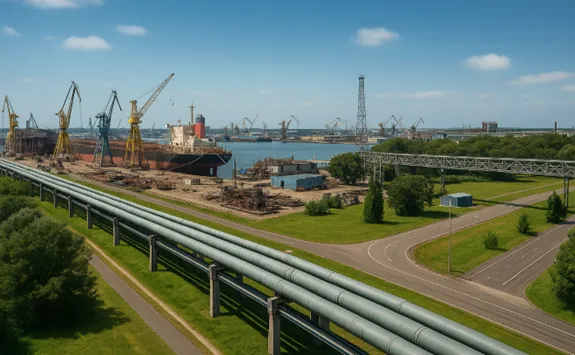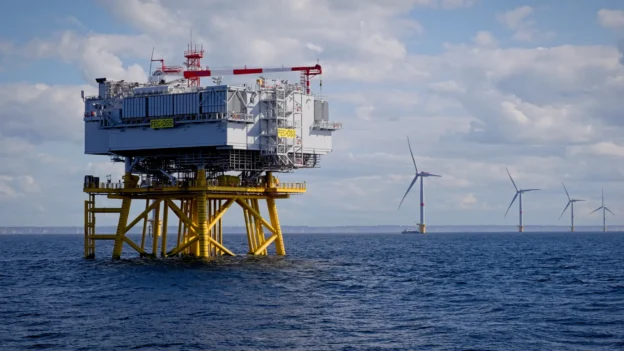The energy transition is not unfolding in a vacuum or in a sterile laboratory; it’s happening in real territories, rich with industrial history, and in communities that for decades have built their lives around hydrocarbons. There, platforms, shipyards, pipelines, and refineries once stood as symbols of progress, but also of fossil dependency. Today, however, that same geography, once defined by oil extraction, emerges as the foundation upon which to build a cleaner energy future.
The challenge lies in transforming billion-dollar infrastructures designed for a specific purpose and redirecting highly specialized human capital toward new value chains. Yet the opportunity is equally immense: to convert what once seemed like an environmental and economic liability into a springboard for large-scale renewable energy.
Technical and strategic keys to the energy transition
From an engineering and economic perspective, the energy transition represents a structural change, where engineering, economics, and sustainability converge. This process requires leveraging the technical legacy of the fossil fuel industry, developing adaptable infrastructure, and ensuring reliability through rigorous standards. In turn, pioneering projects demonstrate the viability of this transformation, redefining global geopolitical and economic balances towards a new, safer, and more efficient energy matrix.
From an engineering and economic perspective, we can currently explore this transition by focusing on four key areas:
- The infrastructure and local knowledge inherited from the fossil fuel industry.
- Flagship projects that demonstrate the technical and economic feasibility of this transition.
- The importance of reliability guaranteed by corrosion and inspection standards.
- The global impacts on the economy and energy geopolitics.
Infrastructure and Local Knowledge
One of the greatest misconceptions surrounding the energy transition is assuming it must start from scratch. Reality is far more complex—and more promising—inviting us to design strategies that optimize existing resources. Many oil-producing regions possess infrastructures that represent both a legacy and a comparative advantage. So, what can be leveraged from them?
Port and logistical infrastructure
Deep-water ports developed for the offshore oil industry—such as Aberdeen in Scotland, Stavanger in Norway, and Ciudad del Carmen in Mexico—were designed to handle equipment weighing hundreds of tons, supply distant platforms, and withstand extreme maritime conditions. Today, these same capabilities are being repurposed for the manufacturing and transport of offshore wind turbines, whose towers can exceed 100 meters in height and weigh over 500 tons. Shipyards and cranes, once focused on repairing oil tankers, now find new technical and economic niches in assembling monopile and jacket foundations.

Underground networks and energy corridors
A vast network of gas pipelines, built over decades, constitutes a valuable asset that would be extremely costly to replicate for new energy systems like hydrogen. These can be adapted through blending or technical retrofits to extend their operational usefulness (International Energy Agency, 2021). In Europe, for instance, pilot projects already inject up to 20% hydrogen into natural gas networks, proving both their operational and regulatory feasibility.
Specialized human capital
Beyond the material, the transfer of technical knowledge is the most valuable asset. Corrosion engineers, certified welders, offshore vessel operators, and nondestructive testing technicians represent highly specialized and scarce human capital. Trained for decades in challenging environments—deep offshore, deserts, jungles—they possess know-how directly transferable to renewable projects. This transition does not erase competencies; it repurposes them. Socioeconomically, it preserves employment and community cohesion, preventing abrupt industrial displacement and social fractures.
Landmark projects
Finding energy solutions for the future requires engineers to conduct research and execute large-scale projects aligned with the decarbonization agenda. Technical arguments gain weight when backed by tangible examples that ensure those objectives. In this sense, several international cases illustrate how oil geographies are being redefined through renewable energy.
Dogger Bank, United Kingdom
The United Kingdom has long sought energy self-sufficiency. Once completed, Dogger Bank will be the largest offshore wind farm in the world, with over 3.6 GW of installed capacity. Its success lies not only in power generation but in how it leverages oil infrastructure.
For example, a recent publication highlights that port facilities such as the Port of Tyne—home to specialized shipyards and a workforce that for decades served oil platforms—are now being repurposed for offshore wind (Equinor, 2023). In other words, the supply and service chain remains intact but with a new vision. Risk management and logistics in rough seas are not skills that can be improvised; they are inherited from the fossil industry.
HyNet North West, United Kingdom
This project is even more compelling because it represents circular economy principles applied at scale. According to HyNet (2022), it is repurposing existing infrastructure by converting decommissioned natural gas fields into CO₂ storage sites, capturing emissions from local industries, and reusing former gas pipelines to transport low-carbon hydrogen. From a technical standpoint, this requires detailed geological studies, well integrity certifications, and compressor adaptations for new operational conditions. Economically, it’s a remarkable opportunity, enabling a gradual, cost-efficient transition with minimal disruption.
Emerging Cases in Latin America
While Europe leads the renewable shift with such emblematic projects, Latin America—particularly Chile and Brazil—is showing growing potential. Chile, for instance, is adapting its oil ports for green hydrogen plants and modules while harnessing the strong winds of the Magellan Strait. Brazil is exploring how its offshore expertise from the pre-salt era can be reused to develop wind power in the South Atlantic. These examples confirm that the narrative is not Eurocentric—it’s global.
Reliability
The construction of large-scale renewable infrastructure cannot be improvised. An offshore wind farm with a 25–30-year lifespan or a green hydrogen plant in a coastal environment is only viable if its technical reliability is guaranteed. This is where materials protection and inspection disciplines become central.
The risk of corrosion
As is well known, corrosion is the main threat to metallic assets exposed to marine environments. For offshore foundations, an inadequate cathodic protection design can shorten structural lifespan to less than 10 years, leading to astronomical repair costs. This is just one example of the preventive measures required; in general, corrosion prevention and mitigation programs apply to all assets involved in production processes.
The role of AMPP
The Association for Materials Protection and Performance (AMPP) was formed from the merger of NACE International and SSPC, setting standards for material selection, epoxy coatings, cathodic protection systems, and monitoring methodologies. These guidelines—often unnoticed outside the technical community—are crucial for ensuring that multi-billion-dollar projects remain financially viable. AMPP also promotes testing initiatives for civil and defense infrastructure, strategic geographies, and emerging industries within the energy and gas sectors, all underpinned by material performance and protection.
The contribution of ASNT
Meanwhile, the American Society for Nondestructive Testing (ASNT) certifies professionals in nondestructive testing (NDT) methods such as ultrasound, industrial radiography, and magnetic particle inspection, among others (ASNT, 2023). These tests act as medical checkups for infrastructure, ensuring that small cracks or defects don’t evolve into catastrophic failures, thus maintaining asset integrity and operability.
The synergy between organizations
To ensure optimal asset performance during repurposing, quality assurance and reliability standards must be unified. AMPP provides corrosion control guidelines for CO₂ and hydrogen pipelines, as well as for wind farms and solar plants. These standards reduce costs, emissions, and operational failures, extending asset lifespan and reinforcing trustworthy energy management.
ASNT, on the other hand, continues advancing research and development in NDT methods, with results verified by certified professionals. AMPP establishes prevention from the start, while ASNT ensures those standards are upheld. This partnership builds not only technical confidence but also financial assurance—considering certifications as safeguards of resilience that attract capital to the energy transition.
What levels of impact are generated?
The shift from oil-based to renewable regions carries consequences that transcend local boundaries, reshaping global energy geopolitics. The ripple effects of these transformations extend across production and market strategies alike.
Diversification and supply chains
The rise of new renewable energy hubs across diverse geographies diversifies sources and reduces global vulnerability to crises. Strengthening this diversification is key to ensuring the resilience and functional logic of future energy systems.
Emerging markets
Around the world, researchers and project developers continue to seek ways to improve quality of life without harming the planet. Economically, the development of next-generation turbines, advanced electrolyzers, and monitoring sensors is creating a massive technological market. A report by IRENA (2021) estimates that by 2030, the renewable sector could generate over 30 million jobs worldwide—many of them industrial and highly skilled.
Decarbonization, in this sense, doesn’t require dismantling industrial structures but transforming them. For nations such as Venezuela, Nigeria, and Saudi Arabia—facing the dilemma of fossil dependence while striving to join the low-carbon economy—this represents a crucial blueprint.
Conclusions
Ultimately, the energy transition is not a leap into the void; it’s a geopolitical and geostrategic reinterpretation. Leveraging the infrastructure, human talent, and geography that sustained the oil era now forms the foundation of a new renewable matrix. Projects like Dogger Bank and HyNet prove that conversion is both technically and economically feasible, while organizations such as AMPP and ASNT ensure the reliability that underpins investment viability.
In the end, and to remain as objective and optimistic as possible, the oil legacy is not an obstacle—but an ally. The energy transition can be understood as a collective re-skilling effort and an engineering reinvention of existing infrastructures, capable of transforming both local economies and global geopolitics. The future energy map is becoming a forecast of medium-term scenarios—a platform for a more resilient, diversified, and sustainable system.
References
- ASNT. (2023). What is Nondestructive Testing? American Society for Nondestructive Testing. https://www.asnt.org/
- Equinor. (2023). Dogger Bank Wind Farm. https://www.equinor.com/energy/dogger-bank
- HyNet. (2022). What is HyNet? https://hynet.co.uk/
- International Energy Agency (IEA). (2021). Net Zero by 2050: A Roadmap for the Global Energy Sector. IEA Publications. https://www.iea.org/reports/net-zero-by-2050
- IRENA. (2021). Renewable Energy and Jobs – Annual Review 2021. International Renewable Energy Agency. https://www.irena.org/publications/2021/Oct/Renewable-Energy-and-Jobs-Annual-Review-2021

